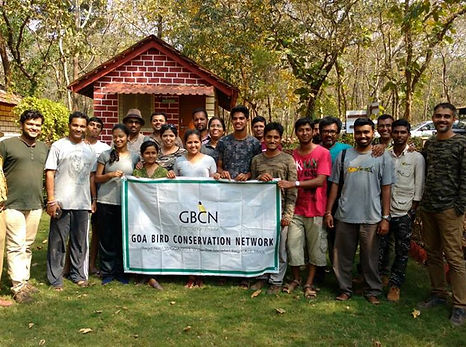SrNo
SrNo
_edited.png)
Goa Bird Conservation Network
Bird Counts & Surveys
The First All Goa Waterfowl Count (AGWC)- January 2016
The first All Goa Waterfowl Count (AGWC) was held in two phases, on 18th January 2015 covering North Goa and 25th January 2015 covering South Goa. Teams comprising of expert birders and volunteers covered important wetlands in the two districts of the State on both the days conducting total bird counts. The count started simultaneously at all the selected wetlands on the appointed days. At the end of the day, team leaders uploaded their checklists on eBird. The data so obtained was then submitted to Wetlands International. The aim of the AGWC was to systematically conduct surveys of wetlands of importance in the state which are host for migratory bird populations. The whole event was coordinated by Pronoy Baidya, Goa state coordinator for Wetland International.


LONG TERM BIRD MONITORING PROJECT, Cotigao WLS,GOA-2016-17

Long-term Bird Monitoring Program has been initiated jointly by Goa Forest Department and Goa Bird Conservation Network. The first phase has been implemented in Cotigao Wildlife Sanctuary, situated in Cancona taluka of Goa. The monitoring program has been implemented as a set of three surveys covering three distinct seasons of the state viz. Post-Monsoon, Winter and Pre-Monsoon. Surveys were conducted on 22 & 23 October 2016- 1st survey (post-monsoon season), 18 & 19 February 2017- 2nd survey (winter season) and 20 & 21 May 2017- 3rd survey (pre-monsoon season). 45 volunteers from Goa Bird Conservation Network and all Forest Department officials from Cotigao Wildlife Sanctuary took part in these surveys.


Pilot Bird Survey at Mhadei WLS-2014

GBCN planned and executed a bird survey in Mhadei wildlife sanctuary from 14-16 March 2014 in association with the Goa forest department. The purpose of the survey was to cover just a part of the protected area which will act as a pilot survey for future surveys that we wish to conduct. With recommendations from the then Range Forest Officer of Mhadei wildlife sanctuary, Codal beat was chosen to conduct the survey. Six transects were laid so as to uniformly cover the area. Each transect was surveyed three times over the course of 2 days by six different teams. Each team had 2-3 members accompanied by a forest guard. Night survey was also carried out along two transects for nocturnal birds. Timed-species count method was used to record the data.
The First All Goa Waterfowl Count (AGWC)- January 2016
The first All Goa Waterfowl Count (AGWC) was held in two phases, on 18th January 2015 covering North Goa and 25th January 2015 covering South Goa. Teams comprising of expert birders and volunteers covered important wetlands in the two districts of the State on both the days conducting total bird counts. The count started simultaneously at all the selected wetlands on the appointed days. At the end of the day, team leaders uploaded their checklists on eBird. The data so obtained was then submitted to Wetlands International. The aim of the AGWC was to systematically conduct surveys of wetlands of importance in the state which are host for migratory bird populations. The whole event was coordinated by Pronoy Baidya, Goa state coordinator for Wetland International.

